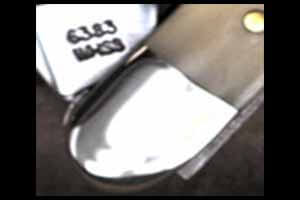Unveiling the Legacy of Timeless Craftsmanship If you find yourself in possession of a Case knife, you have stumbled upon a piece of cutlery history worth exploring. Dating a Case knife allows you to unravel its origins, uncovering a legacy of time-honored craftsmanship and tradition. With distinctive tang stamps, shield variations, and other identifying characteristics, understanding how to date a Case knife reveals its age and authenticity, connecting you to a specific era and the skilled artisans who shaped it. To find out dating a Case Knife, you must have to prepare to delve into a captivating journey through the annals of knife-making, where each blade tells a unique story of excellence and enduring quality. So, let’s get started.
Related:
Contents
Short History of Case Knives
Case Knives, an esteemed American cutlery brand, traces its roots back to 1889 when it was established by the Case family in Bradford, Pennsylvania. From its humble beginnings, Case Knives quickly gained recognition for their exceptional craftsmanship and commitment to quality. The brand’s unwavering dedication to precision and attention to detail propelled its knives to become trusted companions for both everyday users and collectors alike. Over the years, Case Knives has remained steadfast in preserving time-honored traditions, creating iconic patterns and employing skilled artisans to shape each blade with meticulous care. Today, Case Knives continues to be celebrated as a symbol of enduring American craftsmanship and a testament to the brand’s rich history.
How to Date a Case Knife?
We can date a knife using various methods. In the case of dating a Case Knife, we will follow some steps. However, to date a Case Knife and determine its age, you can follow the following steps:
Tang Stamps:
Examine the tang, the portion of the blade that extends into the handle. Case knives have used distinct tang stamps throughout different periods, often including a combination of dots, X’s, and other symbols. Consult Case knife dating guides or online resources to match the tang stamp with a specific timeframe.
| Tang Stamps Information | Images |
|---|---|
| In 1970, Case implemented a significant change by introducing ten dots below the U.S.A. on all knife tangs. As a symbolic representation of time, each subsequent year witnessed the removal of one dot. |  |
| During the 1980s, Case continued to utilize the same dating system. However, there were a couple of notable distinctions. Firstly, the letter S in “Case” and “USA” took on a distinct lightning-like appearance. Additionally, the dots were positioned above the “USA” rather than below it. |  |
| From 1990 until the middle of 1993, Case adopted a different approach by directly stamping the actual date on the tang of their knives. This departure from the previous dating system provided a more precise indication of the specific date during that period. |  |
| Starting from the middle of 1993, Case reverted back to employing the dot system once again, which remained in use until the year 1999. This period saw the return of the familiar dot-based dating system to mark the manufacturing years of their knives. |  |
| In the year 2000, Case implemented a fresh tang date stamp featuring five X’s and five dots. Subsequently, between 2001 and 2005, a dot was eliminated annually to reflect the passing years. Following that, from 2006 to 2009, an X was removed each year, signifying the progression of time. This updated system brought about a distinctive way of indicating the manufacturing dates on Case knives during this period. |  |
| The Tang Stamp design for 2010 reintroduced the utilization of five X’s and five dots. For the subsequent period of 2011 to 2015, a single dot was removed each year to denote the passing of time. Then, from 2016 to 2019, an X was eliminated annually, continuing the tradition of symbolizing the years through the gradual removal of these markings. This Tang Stamp design served as a consistent and recognizable feature for Case knives during this timeframe. |  |
| For the Tang Stamp design of 2020, Case returned to the original format of using ten dots without the inclusion of a Long Tail C. Subsequently, from 2021 to 2029, a single dot was removed each year, mirroring the established practice of representing the passing years. This revised Tang Stamp design became a characteristic feature of Case knives during this period, showcasing their commitment to both tradition and craftsmanship. |  |
Pattern Stamps

Throughout Case’s extensive history, a vast array of knife patterns have been crafted, amounting to hundreds of unique designs. To assist collectors in identifying these distinct patterns, Case devised a distinctive numbering system. If you own a Case knife, you can locate the pattern number on the tang of the blade. This number provides precise information about the type of knife you possess. The initial digit denotes the handle material, while the second digit signifies the number of blades. The remaining two or more digits represent the factory pattern number, serving as a specific identifier for the particular design.
Handle Materials

Case knives are available in various handle materials, each offering its own unique aesthetic and functional qualities. Some common handle materials used by Case include:
- Bone: Traditional bone handles, often made from cow bone, provide a classic and natural appearance. They can be found in different colors, such as white, amber, or even dyed variations.
- Stag: Stag handles are crafted from deer antlers and are prized for their rugged and rustic appeal. They offer a distinct texture and rich tones, making each handle unique.
- Wood: Case utilizes different types of wood, such as rosewood, walnut, or oak, to create handles with warm and natural tones. Wood handles offer a comfortable grip and a timeless look.
- Synthetic: Synthetic handles, such as Delrin or synthetic composites, are popular for their durability, resistance to moisture, and wide range of colors and patterns. They provide a versatile and practical option.
- Micarta: Micarta handles are made by layering resin-soaked cloth or paper, which creates a sturdy and textured material. Micarta handles are known for their excellent grip and resistance to wear.
- G-10: G-10 handles are constructed from fiberglass laminate, making them incredibly durable, lightweight, and resistant to moisture and chemicals. They often feature a textured surface for enhanced grip.
These are just a few examples of the handle materials used by Case. Each material offers its own unique characteristics, allowing individuals to choose the one that best suits their preferences and needs.
Let’s make a table.
| 1 | Solid Hardwoods |
| 2 | Smooth Black Synthetic Thermoplastic Rubber |
| 3 | Smooth Yellow Synthetic |
| 4 | Smooth Synthetic |
| 5 | Genuine Stag |
| 6 | Jigged Bone, Jigged Synthetic, Jigged Laminate |
| 6.5 | BoneStag |
| 7/P | Curly Maple, Rosewood, Smooth Laminate |
| 8 | Genuine Mother-of-Pearl |
| 9 | Imitation Mother-of-Pearl |
| 10 | Micarta, G-10 |
| I | Ivory, Imitation Ivory |
| EX | Exotic (Giraffe, Ostrich, Volcanic Glass, and other Exotic Handle Materials |
Shield Variations:
Look at the shield on the handle. Case knives have featured various shield designs over the years. Research the different shield variations and compare them to identify which era your knife belongs to.

Pattern Identification:
Identify the specific pattern of your Case knife. Classic patterns like the Trapper, Stockman, or Peanut have been produced by Case Knives for decades. Knowing the production history of each pattern can help narrow down the knife’s age.
One of the most important questions in terms of identifying the date of a Case Knife is how to identify Case Knife patterns. Well, you can easily do it if you know the secret codes. We will now see an example and find out the meaning of the Case Knife Patterns.
You can see an image here along with some numbers in it.
In this example, 6347 is a 47-pattern knife with jigged bone handles and 3 blades.
Blade Etchings:
Some Case knives may have etchings or engravings on the blade, such as logos, designs, or model names. These markings can provide clues about the knife’s age, especially if they have changed or evolved over time.
Consult Experts:
If you’re uncertain about dating your Case knife, reach out to knowledgeable knife collectors, dealers, or Case Knife enthusiasts. They may have expertise in identifying specific characteristics and can assist you in determining its age.
Remember that dating a Case Knife can be a nuanced process, and there may be exceptions or variations within specific periods. It’s essential to use multiple sources and references to cross-reference the information and arrive at a more accurate estimation of your Case knife’s age.
How to determine the year a Case knife was made?
To determine the year a Case knife was made, it is necessary to examine the tang stamp on the blade. Besides, the specific markings, such as dots or date stamps, can indicate the manufacturing year. Additionally, referring to online Case knife dating guides or consulting with experts can provide further insights into identifying the knife’s production year accurately.
Let’s see a Case Knife Year list below:
| Tang logo → Tang stamp → Year -------------------------------------------------- CASE XX U.S.A. block letters→ 10 dots→ 1970 CASE XX U.S.A. block letters→ 9 dots→ 1971 CASE XX U.S.A. block letters→ 8 dots→ 1972 CASE XX U.S.A. block letters→ 7 dots→ 1973 CASE XX U.S.A. block letters→ 6 dots→ 1974 CASE XX U.S.A. block letters→ 5 dots→ 1975 CASE XX U.S.A. block letters→ 4 dots→ 1976 CASE XX U.S.A. block letters→ 3 dots→ 1977 CASE XX U.S.A. block letters→ 2 dots→ 1978 CASE XX U.S.A. block letters→ 1 dot→ 1979 Case XX U.S.A. lightning bolt S→ 10 dots→ 1980 Case XX U.S.A. lightning bolt S → 9 dots→1981 Case XX U.S.A. lightning bolt S → 8 dots→1982 Case XX U.S.A. lightning bolt S→ 7 dots→ 1983 Case XX U.S.A. lightning bolt S→ 6 dots→ 1984 Case XX U.S.A. lightning bolt S→ 5 dots→ 1985 Case XX U.S.A. lightning bolt S→ 4 dots→ 1986 Case XX U.S.A. lightning bolt S→ 3 dots→ 1987 Case XX U.S.A. lightning bolt S→ 2 dots→ 1988 Case XX U.S.A. lightning bolt S→ 1 dot→1989 19 USA 90 1990→ date stamped 19 USA 91 1991→ date stamped 19 USA 92 1992→ date stamped 19 USA 93 1993→ date stamped CASE XX U.S.A. long-tail C→ 7 dots→ 1993 CASE XX U.S.A. long-tail C→ 6 dots→ 1994 CASE XX U.S.A. long-tail C→ 5 dots→ 1995 CASE XX U.S.A. long-tail C→ 4 dots→ 1996 CASE XX U.S.A. long-tail C→ 3 dots→ 1997 CASE XX U.S.A. long-tail C→ 2 dots→ 1998 CASE XX U.S.A. long-tail C→ 1 dot→ 1999 Case XX thin long-tail C→ 5 x 5 dots→ 2000 Case XX thin long-tail C→ 5 x 4 dots→ 2001 Case XX thin long-tail C→ 5 x 3 dots→ 2002 Case XX thin long-tail C→ 5 x 2 dots→ 2003 Case XX thin long-tail C→ 5 x 1 dots→ 2004 Case XX thin long-tail C→ 5 x 0 dots→ 2005 Case XX thin long-tail C→ 4 x→ 2006 Case XX thin long-tail C→ 3 x→ 2007 Case XX thin long-tail C→ 2 x→ 2008 Case XX thin long-tail C→ 1 x→ 2009 Case XX thick long-tail C→ 5 x 5 dots→ 2010 Case XX thick long-tail C→ 5 x 4 dots→ 2011 Case XX thick long-tail C→ 5 x 3 dots→ 2012 Case XX thick long-tail C→ 5 x 2 dots→ 2013 Case XX thick long-tail C→ 5 x 1 dots→ 2014 Case XX thick long-tail C→ 5 x 0 dots→ 2015 Case XX thick long-tail C→ 4 x→ 2016 Case XX thick long-tail C→ 3 x→ 2017 Case XX thick long-tail C→ 2 x→ 2018 Case XX thick long-tail C→ 1 x→ 2019 |
Final Words
In conclusion, dating a Case knife involves examining the tang stamp on the blade, which contains unique markings indicating the manufacturing year. Factors such as the arrangement of dots, lettering styles, or specific date stamps can help determine the knife’s age. By referring to online Case knife dating resources or seeking guidance from knowledgeable experts, enthusiasts can accurately date their Case knives and gain a deeper understanding of their historical significance. Understanding the dating system adds to the appreciation and value of these remarkable pieces of craftsmanship.
Source: casexx

